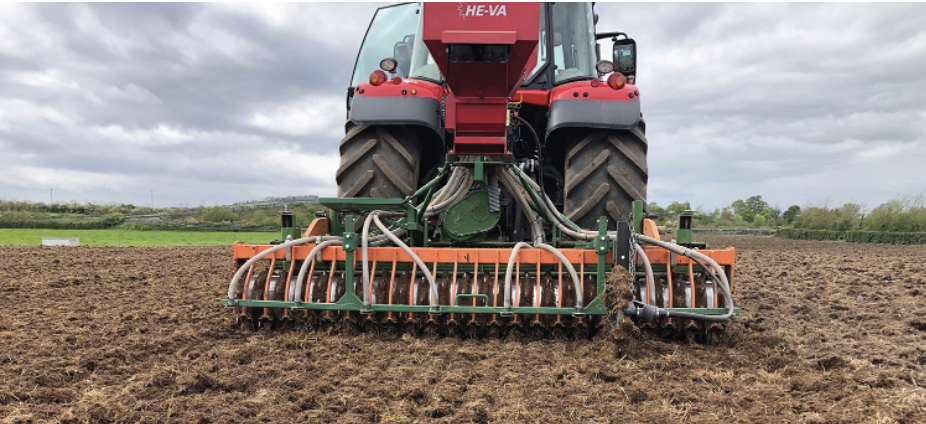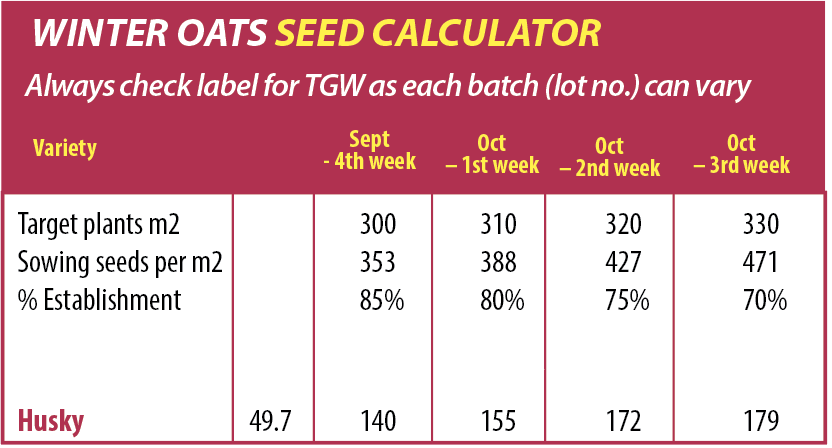After what turned out to be a difficult harvest, harvest 2020 is almost complete with the exception of the remaining bean crop still to be harvested. Farmer’s attention will now turn to preparing ground for the planting of winter cereal crops. Farmers have begun to sow winter crops earlier this year in an effort to avoid the problems that were encountered last autumn. Early sowing of winter cereals from mid to late September usually ensures that farmers can prepare good seedbeds for planting and temperatures are much more favourable to promote fast germination rates and a greater number of plants established.
Sowing
- Early sowing although has benefits is often associated with creating disease and pest problems which can inhibit the profitability and yield of crops.
- Earlier sown winter cereal crops have an increased risk of lodging later on in the crops life cycle, Take all, foliar diseases, problematic grass weeds such as brome and blackgrass, aphids and BYDV.
- The planting of winter cereal crops later in the year in the month of October does significantly reduce the risk of BYDV when compared with September planting.
- Farmers should plan to sow all heavier land and any land with a history of low pressure of BYDV and problem grass weeds incidence such as sterile brome and blackgrass, leaving the most vulnerable land until last to be planted.
- Identify fields with a history of problem weeds such as sterile brome and blackgrass and avoid sowing winter barley in these fields.
- The key germination period for sterile brome species and black grass is September and tapers of as sowing moves into October.
Seed
Drummonds can provide a number of tried and tested seed varieties for winter cereals with a choice of three different seed dressing to suit each farmer’s requirements.
Winter barley Varieties.
KWS CASSIA:
- Is a moderately early maturing two row variety
- Short straw with good resistance to lodging and moderate resistance to straw breakdown.
- Moderately susceptible to mildew and susceptible to rhyncosporium.
- Good resistance to brown rust and net blotch.
- Good grain quality and good hectolitre weight 69.9 kg/hl.
LG CASTING
- Early maturing two row variety.
- High yield potential.
- Moderately susceptible to straw breakdown.
- Good resistance to Rhynchosporium, brown rust and net blotch.
- High resistance to mildew.
- Good hectolitre weight 68.4 kg/hl
TOWER
Tower is a tried and tested variety that may no longer be on the DAFM recommended list. It Yields as well as Castings and has a higher yield than Cassia.
- Early maturing
- High yield potential
- Good resistance to lodging, moderate resistance to straw breakdown
- Susceptible to net blotch
- Moderately resistant to Rhyncosporium, brown rust and mildew
- Large grain size & Good grain quality.
Belfry
- Early maturing hybrid six row, high yield potential
- Good resistance to lodging, moderately susceptible to straw breakdown.
- Good resistance to Rhyncosporium and moderate resistance to mildew. Good resistance to brown rust and net blotch.
Winter barley seed calculator

Winter Wheat Varieties:
Costello:
- Short straw
- Very good resistance to lodging & good resistance to straw breakdown.
- Very good resistance to mildew & yellow rust, Good resistance to fusarium.
- Moderately susceptible to Septoria tritici & sprouting.
Torp:
- High yielding, moderately late maturing variety.
- Good resistance to lodging & moderate resistance to straw breakdown.
- Excellent resistance to septoria tritici
- Moderately susceptible to yellow rust and mildew.
- Susceptible to fusarium.
Graham:
- High Yielding variety
- Good resistance to lodging and straw breakdown.
- Very good resistance to mildew.
- Moderately resistant to septoria tritici, good resistance to yellow rust, fusarium and sprouting.
Winter Wheat seed Calculator

Winter Oats:
Husky:
- Early Maturing.
- High yield potential.
- Short straw, good resistance to lodging & moderately susceptible to straw break down.
- Good grain quality.
- Moderately susceptible to mildew and crown rust.

Drummonds is one of Ireland’s premier seed assemblers and farmers can chose from three options of seed dressing.
Single Purpose dressed seed: (Kinto Plus) Gives the seed protection against all seed and soil borne diseases.
Radiate Dressed: (Zinc based) is an excellent seed dressing for promoting root establishment and growth. Increases yields on average between 0.4 -0.6 t/ha in our trials. With the increase in root mass, fertiliser utilisation is maximised which means the plant can cope better against stress e.g. drought and Take –All
Manganese Dressing: Benefit any soil that is deficient in manganese to ensure efficient and quick establishment.
OSR:

Farmers who have sown oilseed rape should be now walking their crops of OSR to identify if slugs or the flea beetle are present in their crops. Cabbage stem flea beetle attacks seedlings and causes shot holing in the plants
Pest Treatment:
Once cotyledons have unfolded, treatment for cabbage stem flea beetle and slugs should be considered if present (From the time the first leaf unfolds at GS10 to GS29). Karate (lamba –cyhalothrin) is generally the product of choice for CFB .
Post emergence herbicide:
- Should be applied when 6-8 true leaves are present
- Still time for Katamaran Turbo once the weeds are small
- ASTROkerb applied at 1.7 l/ha – Don’t apply until soil temperatures are below 10 degrees celsius
- From November through to January is the ideal timing for Astrokerb
- Volunteer cereal should be sprayed before the 2 leaf stage with a graminicde
Clearfield varieties:
- Clearfield varieties have a tolerance to cleranda.
- Cleranda is a co-form of imazamox + metazachlor
- Rate of use is 2l/ha + Dash 1l/ha (Dash is an adjuvant)
- Cleranda works best when applied to small actively growing weeds.
- Apply to a dry leaf.
- Avoid rain after application.
- Spray window is compromised if left to the end of October.
For more information please contact your local Drummonds Technical Sales Advisor.


